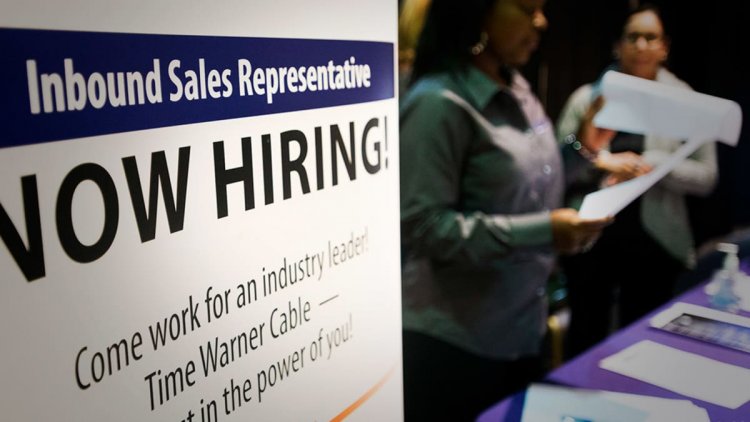Job Market Mystery Complicates Fed Path As Tech Culls, Claims Fall
Falling jobless claims, firm December hiring gains and historically low unemployment in the face of mounting recession risks are adding a new layer of complexity to the Fed's rate messaging.

Falling jobless claims, firm December hiring gains and historically low unemployment in the face of mounting recession risks are adding a new layer of complexity to the Fed's rate messaging.
It's not "the economy, stupid", as political strategist James Carville once famously declared, it's a stupid economy.
Well, at least that how it appears. Bond markets have flashing recession warnings for several months, tech giants are slashing jobs at a worrying pace, retail sales are falling through the floor, even with the boost of cheaper gas prices, and the housing market hasn't been this depressed since the depths of the Covid pandemic.
And yet, stocks are holding onto firm January gains, the Atlanta Fed's GDPNow forecasting tool suggesting the economy will carry the momentum of a 3.5% fourth quarter growth rate into the new year and a key reading of consumer sentiment surged 8.2% from last month, based on University of Michigan data, as inflation pressures eased.
The Federal Reserve, meanwhile, is ignoring all suggestions that it should fade its near-term rate tightening path, telling audiences, reporters and virtually anyone prepared to listen that inflation remains too high and rates will peak at a level that's much higher than current forecasts indicate.
So, what's going on?
It could be the job market, where new claims for unemployment benefits fell by 15,000 last week to just 190,000 -- a level that matches the lowest since September and comes within touching distance of the March 2022 trough of 166,000 -- according to labor market data published Thursday.
"Jobless claims falling for the fourth week in a row is a sign that the labor market is still seemingly able to weather the storm, though the sizable layoffs at blue chips in these past weeks indicate the economic environment is weighing on companies – especially those in the tech sector," said Mike Loewengart, head of model portfolio construction at Morgan Stanley Global Investment Office.
"It seemed like it was a question of if and not when for the rising rate environment to catch up to the labor market, but the debate remains when we will see it lose some of its resiliency amid the Fed’s tightening."
The fact that fewer people are filing for jobless benefits -- when those employed specifically for the holiday season should be looking for work -- only deepens the job market mystery that has complicated the Fed's messaging - not to mention the seven rate hikes, and billions in bonds it's dumped back onto the market, over the past year.
"We do see a very, very strong labor market, one where we haven’t seen much softening, where job growth is very high, where wages are very high," Fed Chairman Jerome Powell told reporters during his mid-December press conference in Washington following the central bank's most recent rate hike.
"Vacancies are quite elevated, and, really, there’s an imbalance in the labor market between supply and demand," he said, adding that taming the impact of wage increases on inflation is '"likely to take a substantial period" of time.
Some of that is already happening: the Bureau of Labor Statistics' December employment report showed a firm gain of 223,000 new jobs but noted wages growing a slower-than-expected pace of 0.3% compared to the previous month and 4.6%, compared to last year.
Yet those figures are hard to square with either the Challenger Gray job cuts report for December layoffs rose 129% from last year to 76,835, or Job Openings and Labor Turnover Survey (Jolts) data for the month of November, which indicated around 10.45 million open positions in the U.S. economy, a level that could feed in to pay gains over the coming months.
Or perhaps not.
Jolts data could be overstating hiring demand, as companies keep listings current even if they don't intend to immediately fill that specific position, and tech layoffs, where the bulk of the cuts are coming from, often include highly-skilled workers that can more quickly find work than those at the lower end of the wage scale.
That said, headlines noting big job cuts a market leaders such as Microsoft (MSFT) - Get Free Report, Amazon (AMZN) - Get Free Report, Goldman Sachs (GS) - Get Free Report and Meta Platforms (META) - Get Free Report could erode business optimism while enticing recalcitrant workers back into the labor force - a move that would lead to a corresponding jump in jobless claims and headline unemployment.
Cleveland Fed President Loretta Mester told the Associated Press yesterday that she hopes higher rates -- which she continues to advocate -- will have a bigger impact on job openings than job losses, thus keeping headline employment rates low and wage gains minimal.
That might be a tougher needle to thread than the infamous "soft landing" the Fed policymakers are hoping to engineer.
Ian Shepherdson of Pantheon Macroeconomics argues that jobless claims lag both the Challenger Gray numbers and the broader economic malaise, as companies slow hiring, before ultimately firing, workers when then begin to see a downturn.
"By the time claims start rising strongly -- especially in today’s post-Covid labor market, with depressed labor participation -- the downturn will be well underway," said.
That puts the Fed in an awkward position: if job gains hold, while inflation slows, it may not need to push ahead with rate hikes and could 'land the plane' and avoid recession.
If job losses escalate, however, it may be too late for the Fed to take its foot off the gas, even if it has no other choice.
What's Your Reaction?


























































